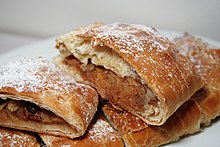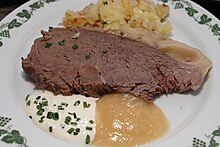
Hungarian or Magyar cuisine is the cuisine characteristic of the nation of Hungary, and its primary ethnic group, the Magyars. Hungarian cuisine has been described as being the spiciest cuisine in Europe. This can largely be attributed to the use of their piquant native spice, Hungarian paprika, in many of their dishes. A mild version of the spice, Hungarian sweet paprika, is commonly used as an alternative. Traditional Hungarian dishes are primarily based on meats, seasonal vegetables, fruits, bread, and dairy products.
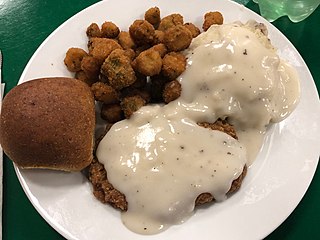
Chicken-fried steak, also known as country-fried steak, is an American breaded cutlet dish consisting of a piece of beefsteak coated with seasoned flour and either deep-fried or pan-fried. It is sometimes associated with the Southern cuisine of the United States. It is breaded and fried with a technique similar to the more common fried chicken, hence "chicken-fried". When deep-fried, it is usually referred to as "chicken-fried steak". Pan-fried versions are typically referred to as "country-fried steak".

Polish cuisine is a style of food preparation originating in and widely popular in Poland. Due to Poland's history, Polish cuisine has evolved over the centuries to be very eclectic, and shares many similarities with other national cuisines. Polish cooking in other cultures is often referred to as à la polonaise.
European cuisine comprises the cuisines originating from the various countries of Europe.
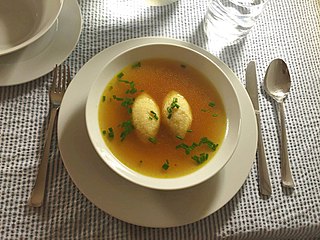
Austrian cuisine consists of many different local or regional cuisines. In addition to Viennese cuisine, which is predominantly based on the cooking traditions of the Habsburg Empire, there are independent regional traditions in all the states of Austria.

A schnitzel is a thin slice of meat. The meat is usually thinned by pounding with a meat tenderizer. Most commonly, the meat is breaded before frying. Breaded schnitzel is popular in many countries and is made using veal, pork, chicken, mutton, beef, or turkey. Schnitzel originated as wiener schnitzel and is very similar to other breaded meat dishes.
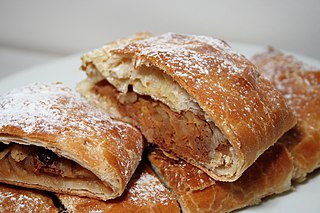
Apple strudel is a traditional Viennese strudel, a popular pastry in Austria, Bavaria, the Czech Republic, Northern Italy, Slovenia, Croatia, and other countries in Europe that once belonged to the Austro-Hungarian Empire (1867–1918).

Croatian cuisine is heterogeneous and is known as a cuisine of the regions, since every region of Croatia has its own distinct culinary tradition. Its roots date back to ancient times. The differences in the selection of foodstuffs and forms of cooking are most notable between those in mainland and those in coastal regions. Mainland cuisine is more characterized by the earlier Slavic and the more recent contacts with Hungarian and Turkish cuisine, using lard for cooking, and spices such as black pepper, paprika, and garlic. The coastal region bears the influences of Greek and Roman cuisine, as well as of the later Mediterranean cuisine, in particular Italian. Coastal cuisines use olive oil, herbs and spices such as rosemary, sage, bay leaf, oregano, marjoram, cinnamon, clove, nutmeg, and lemon and orange rind. Peasant cooking traditions are based on imaginative variations of several basic ingredients and cooking procedures, while bourgeois cuisine involves more complicated procedures and use of selected herbs and spices. Charcuterie is part of the Croatian culinary tradition in all regions. Food and recipes from other former Yugoslav countries are also popular in Croatia.

Strudel is a type of layered pastry with a filling that is usually sweet, but savoury fillings are also common. It became popular in the 18th century throughout the Habsburg Empire. Strudel is part of Austrian cuisine and German cuisine but is also common in other Central European cuisines. In Italy it is recognized as a prodotto agroalimentare tradizionale (PAT) of South Tyrol.

Austrian culture is characterised by historical and modern influences, including a history of interaction primarily between Celtic, Roman, Slavic and Germanic peoples. Austria is particularly known for its classical music, folk music, baroque architecture, coffee culture, winter sports and Alpine traditions.
Serbian cuisine is a Balkan cuisine that consists of the culinary methods and traditions of Serbia. Its roots lie in Serbian history, including centuries of cultural contact and influence with the Greeks and the Byzantine Empire, the Ottomans, and Serbia's Balkan neighbours, especially during the existence of Yugoslavia. Historically, Serbian food develops from pastoral customs that involved the keeping of sheep in mountain highlands, in a climate and regional context that favoured animal husbandry over vegetable farming; Serbian food is therefore traditionally richer in animal products and basic grains—corn, wheat and oats—than fresh vegetable dishes. Following the abandonment of widely practiced pastoral lifestyles, Serbian food emerged through the Middle Ages heavily dependent not on lamb or mutton, but on the keeping of pigs for the annual cull and the production of various cured meats, such as sausages, bacon and ham products.
Cutlet refers to:
- a thin slice of meat from the leg or ribs of mutton, veal, pork, or chicken
- a dish made of such slice, often breaded
- a croquette or cutlet-shaped patty made of ground meat
- a kind of fish cut where the fish is sliced perpendicular to the spine, rather than parallel ; often synonymous with steak
- a prawn or shrimp with its head and outer shell removed, leaving only the flesh and tail
- a mash of vegetables fried with bread

Czech cuisine has both influenced and been influenced by the cuisines of surrounding countries and nations. Many of the cakes and pastries that are popular in Central Europe originated within the Czech lands. Contemporary Czech cuisine is more meat-based than in previous periods; the current abundance of farmable meat has enriched its presence in regional cuisine. Traditionally, meat has been reserved for once-weekly consumption, typically on weekends.

Bavarian cuisine is a style of cooking from Bavaria, Germany. Bavarian cuisine includes many meat and Knödel dishes, and often uses flour. Due to its rural conditions and Alpine climate, primarily crops such as wheat, barley, potatoes, beets, carrots, onion and cabbage do well in Bavaria, being a staple in the German diet.

Wiener schnitzel, sometimes spelled Wienerschnitzel, is a type of schnitzel made of a thin, breaded, pan-fried veal cutlet served without sauce.

Veal Milanese, known in Italian as cotoletta alla milanese, is a popular variety of cotoletta found in the city of Milan. According to some sources it has a French origin and was brought to Milan during the Napoleonic Wars, where it was first known as cotoletta rivoluzione francese. It is traditionally prepared with a veal rib chop or sirloin bone-in and made into a breaded cutlet, fried in butter. Due to its shape, it is often called oreggia d'elefant in Milanese or orecchia d'elefante in Italian, meaning 'elephant's ear'.

Beuschel is a dish that is typically a ragout made from lungs and other organs, such as heart, kidneys, spleen, and tongue, from calf, beef, pork, or game. It is often served with a sour cream sauce and bread dumplings. It is a dish of Viennese cuisine but is widespread in all of Austria, Bavaria, and Bohemia.
